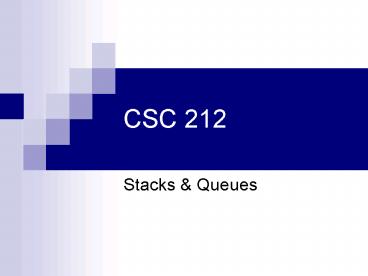CSC 212 - PowerPoint PPT Presentation
1 / 24
Title:
CSC 212
Description:
Title: CSC 212 Author: Matthew Hertz Last modified by: Matthew Hertz Created Date: 9/21/2005 1:20:44 PM Document presentation format: On-screen Show – PowerPoint PPT presentation
Number of Views:82
Avg rating:3.0/5.0
Title: CSC 212
1
CSC 212
- Stacks Queues
2
Announcement
- Daily quizzes accepted electronically only
- Submit via one or other Dropbox
- Cannot force you to compile test them
- Can make it much less work
- Please, please, please use this as an excuse to
practice your Java - Next homework assignment is on web
3
Working Together
- Goal is for students to learn
- Means mistakes are made, questions raised
- Peers useful when learning material
- But the goal is for YOU to learn material
- Talk about homework, daily quizzes all you want
- Leave conversation with only memories, nothing
written, typed, dictated, displayed on a screen - Wait at least 15 minutes before continuing with
homework
4
Queues
- Elements may be inserted at any time
- Only element which has been in queue the longest
may be removed - Items enqueued into rear of queue
- Items dequeued from front of queue
cashier
Front of line Dequeue here
Back of line Enqueue here
5
Queue vs. Stack
- Stack follows LIFO policy
- Last In-First Out
- Objects removed in reverse order of addition
- Queue follows FIFO policy
- First In-First Out
- Objects removed in order they were added
6
Queue ADT
- Queue supports two key methods
- enqueue(obj)Insert obj at the rear of the queue
- dequeue()Returns and removes the object from
front of queue sends error when queue is empty
7
Queue ADT
- Queue also defines other methods
- size()Number of objects in the queue
- isEmpty()Returns if the queue is empty.
- front()Return but do not remove object from
front of queue send error when queue is empty
8
Array-based Queue
- Queue uses array in circular manner
- Also specifies maximum size of queue
- The queue consists of
- N-element array, q
- f, index of the front element
- r, index of the rear element
9
Array-based Queue Pictorial
10
Array-Based Queue Pseudocode
- int size() return (N - f r) mod N
- boolean isEmpty() return(f r)
- Object front()
- if isEmpty() then
- throw QueueEmptyExceptionreturn q f
11
Array-Based Queue Pseudocode
- Object dequeue()
- if isEmpty() then throw QueueEmptyExceptiontem
p ? qfqf ? null - f ? (f 1) mod Nreturn temp
12
Array-Based Queue Pseudocode
- Object enqueue(obj)
- if size() N - 1 then
- throw QueueFullException
- qr ? objr ? (r 1) mod N
13
Daily Quiz 1
- Show the output (if any) and what q, f, r would
equal after each of the following calls (assume N
5) - enqueue(5)
- dequeue()
- enqueue(3)
- enqueue(4)
- enqueue(7)
- isEmpty()
- front()
- dequeue()
- enqueue(1)
- enqueue(2)
- size()
- enqueue(9)
14
Linked Lists
- Linked lists are dynamically allocated collection
of nodes - Pseudocode of Node class
- public class Node Object element Node
next // constructors, get set methods
next
node
elem
15
Adding to Linked Lists
- Maintain a head field/variable
- To insert new node into linked list
- Create initialize new nodenewNode ? new
Node(elem) - Set new nodes next fieldto current value of
headnewNode.setNext(head) - Assign head to the new nodehead ? newNode
16
Deleting from Linked List
- Easy to delete head node
- Save value of headreturnMe ? head
- Move head to next nodehead ? head.getNext()
- Return previous headreturn returnMe
17
Using Linked Lists
- What data structure does a linked list resemble?
- What is the maximum size the linked list can hold?
18
Using Linked Lists
- What is complexity of insert and remove?
- How would you design isEmpty()?
- What is its complexity?
19
Using Linked List
- algorithm size
- Node trav ? head
- int count 0
- while (trav ! null)
- count
- trav ? trav.getNext()
- endwhile
- return count
- What is this complexity?
20
Linked List and Queues
- What is needed to implement a queue with a linked
list? - How would we write this algorithm?
21
DLNode
- public class DLNode
- / prev links to the previous DLNode in the
linked list / - protected DLNode prev
- / next links to the next DLNode in the linked
list / - protected DLNode next
- / element is the data stored at this node /
- protected Object element
- // Not shown here constructors, get set //
routines
22
Deque
- Pronounced deck
- Avoids mistaking it for dequeue method
- Stands for double ended queue
- Enables inserting and removing items at both
front and rear - Uses doubly-linked list
- So uses DLNode rather than Node
23
Deque ADT
- Defines the following methods
- insertFirst(Object e), insertLast(Object e)
- Object removeFirst(), Object removeLast()
- Object first(), Object last()
- int size()
- boolean isEmpty()
- What exceptions should be thrown?
24
Daily Quiz 2
- Use the Queue interface, Node,
EmptyQueueException classes found on the quiz web
page - Implement a linked-list based queue
- You do not need to do any javadoc documentation
- But you can (it is worth 30 of programming
assignment grades)!































